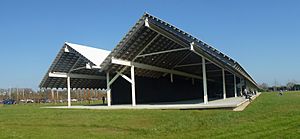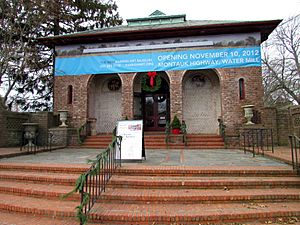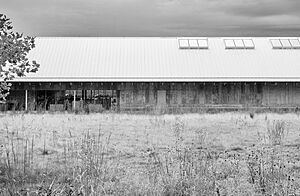Parrish Art Museum facts for kids
 |
|
| Lua error in Module:Location_map at line 420: attempt to index field 'wikibase' (a nil value). | |
| Established | 1898 |
|---|---|
| Location | 279 Montauk Highway Water Mill, NY |
| Visitors | 30,000/yearly (old Jobs Lane location) |
The Parrish Art Museum is an exciting art museum in Water Mill, New York. It was designed by famous architects Herzog & de Meuron. The museum moved to its current home in 2012 from Southampton Village. It mainly shows art by artists who lived and worked in the artist colony areas of South Shore (Long Island) and North Shore (Long Island).
The Parrish Art Museum started in 1898. It has grown into a big art museum with a collection of over 3,500 artworks. These pieces range from the 1800s to today. You can see works by modern artists like John Chamberlain, Chuck Close, Eric Fischl, April Gornik, Donald Sultan, and Elizabeth Peyton. It also features art by masters such as Dan Flavin, Roy Lichtenstein, Jackson Pollock, Lee Krasner, and Willem de Kooning. The museum has some of the most important collections of art by American Impressionist William Merritt Chase and realist painter Fairfield Porter.
Contents
Museum's Story: A Look Back
Early Days in Southampton (1898–2012)
The museum was started in 1898 by Samuel Longstreth Parrish. He was a successful lawyer and a Quaker. Samuel Parrish began collecting art in the 1880s. He built the museum to hold his collection of Italian Renaissance paintings and copies of old sculptures. The first building was designed by Grosvenor Atterbury and built in 1897 in downtown Southampton. It was first called the Art Museum of Southampton. One reason for starting the museum was that William Merritt Chase had founded an art school nearby.
The original building was made bigger twice, in 1902 and 1913. After Samuel Parrish passed away in 1932, he left the museum and its art to the Village of Southampton. But without his leadership, the museum struggled. It wasn't until the 1950s that the museum became lively again. This happened under the new board president, Rebecca Bolling Littlejohn. She realized how important American art was. Mrs. Littlejohn worked to add more American art to the museum's collection. She focused on artists from eastern Long Island, like Thomas Moran, Childe Hassam, and Thomas Doughty. When she passed away, the museum received over 300 paintings, drawings, and watercolors from her own collection. This included works by Martin Johnson Heade, Asher B. Durand, John H. Twachtman, John Sloan, and 31 paintings by American Impressionist William Merritt Chase.
In 1981, the collection grew even more. Nearly 200 artworks by Fairfield Porter were given to the museum. Porter was a well-known American painter, critic, and lived in Southampton for a long time. His wife, Anne, and his art estate donated these works. With these strong collections, the museum now shows how American art has changed over time. It covers early landscape art, the influence of European modern art, and the New York School. The museum focuses on American painting from the 1900s and 2000s. It pays special attention to artists who lived and worked on Long Island's East End. Many famous artists like Jackson Pollock, Willem de Kooning, and Roy Lichtenstein once lived there. Today, artists like Chuck Close, Ross Bleckner, April Gornik, Eric Fischl, and Donald Sultan live there.
The museum had a lot of its art stored away because the buildings were too small. In 2000, it bought the nearby Rogers Memorial Library building to use as an extra space. However, even with this addition, the buildings were still not big enough for the growing collection. The library building was later sold in 2012 when the museum moved to Water Mill. The original Parrish building in Southampton is now being updated to become the new Southampton Center.
New Home in Water Mill (2012–Present)
The museum needed more space and a modern building to protect its art. So, in 2005, the museum bought a 14-acre (57,000 square meter) piece of land in Water Mill, New York. This new spot was next to the Duck Walk Vineyards winery. It was about 2.3 miles (3.7 km) from the old location. After looking at many architects, the museum chose Pritzker Prize winners Herzog & de Meuron to design the new building.
The first design by Herzog & de Meuron was for a large museum with many smaller buildings. But during the 2008 financial crisis, the museum had to make its plans much smaller. The new building was designed to be like a very long barn, 615 feet long and 95 feet wide. It has strong concrete walls. The building is 34,000 square feet inside. It also has a large porch and spaces for education and other activities.
Inside, the museum is simple and on one floor. The public areas like the reception, store, and café are on one side. Offices and art handling areas are on the other. The art galleries are in two rows on either side of a main hall. There are seven galleries for the permanent collection and three for special temporary shows. All the galleries use natural daylight, which changes throughout the day and seasons. The building is placed to catch the special "Hamptons light." This light is thought to be a reason why many artists have loved the area. The new museum officially opened on November 10, 2012.
Amazing Art Collections
William Merritt Chase's Art
The Parrish Art Museum has the largest public collection of art by William Merritt Chase. It includes over 40 paintings and works on paper. The museum also has many old photos related to his life and work. These photos show his family during summers on the East End of Long Island.
Chase was a fantastic portrait and landscape painter. He was also an amazing art teacher. When people in Southampton wanted to start an art school, they chose Mr. Chase to be the first teacher. This school was called the Shinnecock Hills Summer School of Art.
The museum's collection shows art from all parts of his career. This includes his early painting Still Life with Fruit (1871). You can also see works from his famous New York park series, like Park in Brooklyn (around 1887). There are also major studio paintings from the 1880s, such as The Blue Kimono (around 1888). And, of course, there are paintings he made during his summers in the Shinnecock Hills, like The Bayberry Bush (around 1895).
Fairfield Porter's Works
Fairfield Porter was one of the most important American realist painters from 1949 until he passed away in 1975. During these years, Porter lived in Southampton, New York. In 1979, his family and estate recognized his connection to the museum. They donated about 250 of his artworks to the Parrish collection.
Porter was a talented painter and a great writer. He wrote some of the clearest art reviews and comments of his time. He wrote for the magazine Art News. Porter always said he painted what he saw, not what he thought should be there. He painted things he knew well: his family, friends, and the places he lived and visited. This included Southampton, New York and a family island off the coast of Maine.
Porter wrote about the cozy interior paintings of French artists Vuillard and Bonnard. He found that in their art, which showed everyday things, "the extraordinary is everywhere." Porter always painted in a realistic style. But he knew and admired many Abstract Expressionist artists on the East End, especially Willem de Kooning. Porter once wrote that realist art is great in its form, and the best abstract art makes you feel a strong sense of reality.
Other Important Collections
While the Chase and Porter collections are very important, the museum's permanent collection has a wide range of art. In 1958, Alfred Corning Clark gave the Parrish over two dozen paintings and watercolors. These included works by Ralph Blakelock, James A. M. Whistler, William Glackens, and Arthur B. Davies. A year later, Clark also gave works by William Sidney Mount, Winslow Homer, Ernest Lawson, and Charles Burchfield. In 1961, Mrs. Littlejohn left the museum works by John Frederick Kensett, Otis Bullard, E. L. Henry, George Luks, and Everett Shinn, among others.
Since the Porter donation in 1975, the Parrish has focused more on American painting from the 1900s and 2000s. It especially highlights artists who have had studios on the East End of Long Island since the 1950s. Some of these artists in the collection include Jane Freilicher, Larry Rivers, James Brooks, Alfonso Ossorio, Esteban Vicente, Jane Wilson, and Robert Dash. More recent artists from the East End whose work the museum holds are Chuck Close, Joan Snyder, Joe Zucker, Alice Aycock, Lynda Benglis, April Gornik, Keith Sonnier, Mary Heilmann, and Malcolm Morley. The museum also continues to add to its collection of earlier 20th-century art.
The collection also has many prints and drawings. These include works by George Bellows, Marsden Hartley, Larry Rivers, Helen Frankenthaler, and Robert Rauschenberg. In 1982, Paul F. Walter donated drawings by many Minimalist artists. These included Barry Le Va, Dorothea Rockburne, Mel Bochner, and Jennifer Bartlett. Robert Dunnigan gave the museum over 500 etchings in 1976. These prints were by many American artists who were part of the "painter-etcher" movement in the late 1800s. The museum's print collection also has nearly 200 Japanese woodblock prints. These were part of the Littlejohn donation. They are from the 1800s and 1900s and offer a contrast to American prints from the same time.
In 2023, the Parrish Art Museum added an artwork called 'Chisme' by Salvadoran artist Studio Lenca. This piece was created during an artist stay in Miami. It was made with the help of the low-wage workers union WeCount! in South Florida.
Special Exhibitions
The museum usually holds four or five special exhibitions each year. Some recent shows, like Fairfield Porter: Raw—The Creative Process of an American Master and American Landscapes: Treasures from the Parrish Art Museum, use art from the museum's own collection. But most exhibitions are put together by Parrish curators. They explore different ideas and themes in art.
Recent solo shows have featured artists like Alice Aycock: Some Stories are Worth Repeating; Jennifer Bartlett: History of the Universe—Paintings 1970–2011; Rackstraw Downes: Onsite Paintings, 1972–2008; Alex Katz: Seeing, Drawing, Making; Roy Lichtenstein: American Indian Encounters; Platform: Maya Lin; Platform: Josephine Meckseper; Jean Luc Mylayne; Alan Shields: Stirring the Waters; Michelle Stuart: Drawn from Nature; and Jack Youngerman: Folding Screen Paintings.
Some notable group exhibitions have included Encouraging American Genius: Master Paintings from the Corcoran Gallery of Art; All the More Real; Sand: Memory, Meaning, and Metaphor; Modern Photographs: The Machine, the Body, and the City; and Damaged Romanticism: A Mirror of Modern Emotion.
The Parrish also has a long history of juried exhibitions. For most of the museum's history, these shows were open to all artists. A panel of three judges would choose the artworks. In 2008, the format changed to celebrate the art of the East End. It was renamed Artists Choose Artists. Only artists from eastern Long Island could submit their work. Nine established artists from the region reviewed the digital entries. Each judge chose artists to visit in their studios. Then, they selected two artists to include in the show, along with examples of their own work. This new format focused on local artists and helped artists at different stages of their careers connect. Artists Choose Artists of the East End is still a regular program.
After the Parrish moved to Water Mill in November 2012, it gained more exhibition space. It has 4,600 square feet for temporary exhibitions and 7,600 square feet to show its permanent collection. Recent shows have focused on Steven and William Ladd; Alan Shields; Jules Feiffer; Joe Zucker; Robert Dash; Chuck Close; and Andreas Gursky. Future shows will feature Jane Freilicher and Jane Wilson; Alexis Rockman; Ross Bleckner; Eric Fischl, and David Salle.
In an interview in July 2012, the museum's director, Terrie Sultan, said that for the opening in November 2012, the Parrish would show art from all periods of its 2,600-work collection. Many pieces would be new to visitors. During the building project, the museum acquired more paintings and sculptures. These included a large Louise Nevelson sculpture, Dorothea Rockburne's "Touchstone," and Rainer Fetting's "Two Sunsets in East Hampton." Sultan also mentioned that the museum hoped to get a major Jackson Pollock piece and more great Abstract Expressionism works.
Museum Leaders
- 2008–2020: Terrie Sultan
- 2021: Kelly Taxter
- 2022: Melanie Crader (ad interim - meaning temporary)
- 2022–present: Mónica Ramírez-Montagut




